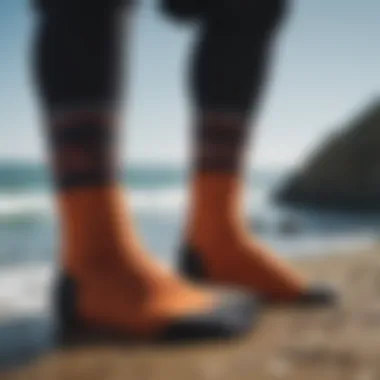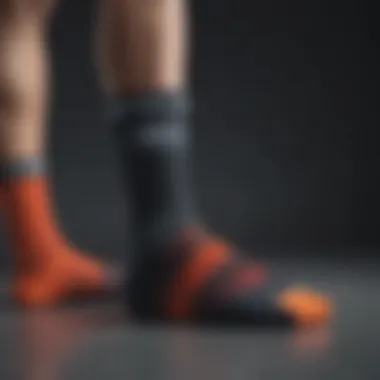Ultimate Guide to Dakine Board Socks for Surfers


Intro
When it comes to protecting your surfboard, choosing the right gear is essential. One often overlooked yet vital item is the board sock. Dakine board socks have gained notable attention within the surf community, not only for their functionality but also for their thoughtful design. This guide will explore the unique features of Dakine board socks, their contribution to the overall surfing experience, and why they are an indispensable part of a surfer's equipment.
The utility of Dakine board socks extends beyond mere protection. They enhance performance by providing a snug fit that keeps your board secure during transport. As surfers, we understand the importance of maintaining our gear in optimal condition, especially when we are eager to hit the waves. With various materials, sizes, and care instructions available, Dakine is at the forefront, offering products that cater to both novice and seasoned surfers.
This comprehensive guide aims to present key points about Dakine board socks while situating them within the larger realm of surfing. This includes an analysis of their material choices, the significance of size selection, and practical care tips. Furthermore, it will identify the broader impact high-quality board socks can have on your surfing adventure.
Preface to Dakine Board Socks
Dakine board socks have become essential for surfers who want to protect their boards. This section explores their significance and the factors contributing to their necessity. Within the surfboarding culture, these items enhance not just the gear's durability but also the overall experience on the water. Understanding Dakine board socks involves looking into their historical context and the pressing need for such protective gear.
Historical Overview of Dakine
Dakine's origins date back to 1979, when it was founded in Hawaii. Initially, the brand focused on creating reliable gear for surfers and snowboarders. Over the years, it has evolved into a highly respected name in the outdoor sports industry. Dakine stands out for its dedication to quality and innovation. With a commitment to the surfing community, Dakine board socks are a result of years of development and refinement. They are designed with surfers’ needs in mind, providing functional designs that withstand the demands of the ocean.
Purpose and Importance of Board Socks
The primary function of board socks is protection. These coverings shield surfboards from scratches, dings, and water exposure during transport. This defense contributes significantly to the longevity of the boards, which can be a considerable investment for many surfers. Moreover, board socks offer additional benefits that enhance the surfing experience:
- Insulation: Keeping boards warm helps maintain performance, especially in colder waters.
- Convenience: Their lightweight nature makes them easy to carry.
- Style: With a variety of designs, they allow surfers to express personal preferences.
In summary, Dakine board socks serve a multifaceted purpose, ensuring the boards remain in optimal condition. They represent not just a protective measure but also an integral part of the surfer's toolkit.
Design and Construction
The design and construction of Dakine board socks are central to their effectiveness and appeal amongst surfers and board sports enthusiasts. A well-constructed board sock not only protects equipment but also contributes to the overall surfing experience. These products blend functionality with innovative design to offer value in usability and protection.
Choosing the Right Material
Materials used in the manufacture of board socks significantly influence their performance and durability. Choosing the right fabric is crucial for ensuring that the board sock serves its intended purpose effectively.
Nylon vs. Polyester
Nylon and polyester are the primary materials in board sock production. Each material has its own unique characteristics.
- Nylon is known for its durability and water resistance. It is often lighter in weight, which enhances portability. However, it may not retain as much flexibility as polyester, which can limit comfort for certain users.
- Polyester, on the other hand, excels in flexibility and breathability. This makes it a popular choice among surfers who need comfort during prolonged use. The trade-off is that polyester may not provide the same level of water resistance as nylon, potentially affecting performance in wet conditions.
Both materials have advantages and disadvantages. Their selection often comes down to personal preferences and specific requirements of the surfer.
Neoprene Benefits
Neoprene is another material sometimes used in Dakine board socks. This type of material adds to the socks’ overall protective features.
One key characteristic of neoprene is its excellent insulation properties. It keeps boards warm and provides another layer of shock absorption, which is beneficial during transport. Furthermore, neoprene is water-resistant, enhancing its appeal for surfers who often encounter wet environments.
While neoprene offers these benefits, it is generally heavier than nylon or polyester. This can be a consideration for surfers who prioritize light gear.
Padding and Protection Features
Padding and protection features are essential aspects of Dakine board socks. They are designed to provide additional safety for your board during transportation and storage.
Impact Resistance


Impact resistance is a critical element of board sock design. Products that boast good impact resistance can significantly reduce the chance of damage to the board during transportation. This feature is particularly valuable for surfers who travel frequently or navigate rougher environments.
The key characteristic here is the shock-absorbent padding that is often integrated into these socks. It acts as a buffer between the board and external forces, preventing unwanted dings or scratches.
While effective, one downside might be that added padding can create bulkiness. For surfers preferring slimmer profiles, this could be a limiting factor in their choice.
Scratch Protection
Another important feature is scratch protection. Board socks designed with this in mind keep your surfboards safe from scratches and abrasions. This is crucial, as even minor scratches can affect performance and longevity.
The unique feature of scratch protection is typically a reinforced exterior area. This protects vulnerable spots on the board, ensuring it remains intact even when tossed around.
Scratch protection does come with trade-offs. A thicker outer material can add weight to the board sock. However, many find that the trade-off is worth it for the added peace of mind during transport and storage.
Sizing and Fit
Understanding the importance of sizing and fit is crucial for optimal performance and protection. Board socks are designed not only to protect your board but also to improve your experience on the water. An ideal fit prevents movement within the sock and ensures your board remains secure. Poorly fitting socks can lead to damage during transport or storage and compromise the gear's integrity. Hence, understanding size charts and fit considerations is essential for any surfer.
Understanding Size Charts
Size charts are vital tools when selecting Dakine board socks. These charts provide measurements that correspond to different sock sizes, taking into account various board dimensions.
- The first step is to measure your board’s length and width.
- Match these dimensions with the size chart provided by Dakine.
- Each board sock may have slight variations in sizing, so cross-referencing ensures a better fit.
Using size charts minimizes the risk of choosing socks that are either too tight or too loose, both of which can hinder performance and protection. Awareness of your equipment’s measurements and the matching sizes will enhance the overall surfing experience.
Fit Considerations for Optimal Performance
Fit considerations significantly impact the performance of board socks. Two fundamental aspects are the snug fit and loose fit, both of which have their pros and cons.
Snug Fit vs. Loose Fit
A snug fit is commonly favored among surfers. This type of fit closely wraps around the board, preventing slippage during transport. The key characteristic of a snug fit is stability. A tighter grip reduces movement inside the sock, protecting against scratches and dings. For surfers who travel frequently, a snug fit is particularly beneficial.
On the other hand, a loose fit may provide ease of removing and putting on the sock. However, the primary disadvantage in this context is the risk of the board shifting within the sock, which can lead to damage. Thus, while a snug fit enhances protection, it might feel restrictive.
Adjustability Features
Adjustability features in board socks allow for a custom fit. These features include adjustable straps or added stretch panels.
- One of the principal benefits of adjustability is that it accommodates various board sizes, ensuring a snug fit for different conditions.
- Another advantage is the added comfort. Whether you prefer a tighter grip or slightly looser, adjustability allows you to find your balance.
However, reliance on these features may lead to complications. If adjustments are not secured properly, they could lead to movement while handling the board. Surfers should regularly check these features to maintain fit and performance.
"Finding the right fit is not just about comfort; it's about safeguarding your investment in your board and enhancing your performance."
In summary, selecting the right fit and size for Dakine board socks is essential. It ensures that the socks do what they are intended: protect the board and contribute positively to the overall surfing experience. Understanding size charts and the implications of fit type will enable surfers to make informed choices.
Versatility of Dakine Board Socks
The versatility of Dakine board socks is one of the key aspects contributing to their popularity among surfers and extreme sports enthusiasts. This adaptability allows these socks to serve multiple purposes, making them an essential item in any surfer's gear collection. Understanding the various ways Dakine board socks can be utilized enhances the overall surfing experience while extending the life of the boards themselves.
Compatibility with Different Board Types
Surfboards


Surfboards are perhaps the most common boards that Dakine board socks cater to. Their primary characteristic is the need for protection during transport and storage. With surfboards often being expensive and delicate, using a board sock helps prevent scratches and dings. The unique padded design ensures that the board remains secure, reducing the risk of damage. Additionally, the snug fit prevents the board from shifting within the sock, which is crucial when traveling.
Skimboards
Skimboards are another category for which Dakine has designed suitable board socks. These boards are typically smaller and often used in different conditions compared to traditional surfboards. The lighter and portable nature of skimboards makes them a popular choice among surfers who enjoy versatility. A Dakine board sock protects against sand and moisture, which can affect performance. The quick-drying material in some models further adds to the appeal by ensuring the board is ready for the next ride.
Kitesurf Boards
Kitesurf boards present a distinct aspect of board care. These boards require specific features, with many tending to be more robust due to the nature of the sport. Dakine board socks accommodate this by providing additional padding without compromising on flexibility. The design allows for easy entry and exit, crucial after a session on the water. The unique feature of kitesurfing boards is their size, which may vary greatly, making it essential to choose a sock that fits well. The right Dakine board sock can effectively guard the board against impacts or abrasion during transportation.
Year-Round Usability
The year-round usability of Dakine board socks cannot be overlooked. While they protect boards during summer trips, their benefits extend to all seasons. This ensures that whether surfers are heading to the sunny beaches or windswept winter coasts, they have reliable protection for their gear. The practicality of using Dakine board socks enhances the surfing experience during varied conditions, making them a sound investment for anyone serious about the sport.
Care and Maintenance of Board Socks
Caring for Dakine board socks is essential to ensure their longevity and continued performance. Proper maintenance not only helps to maintain the sock's structure but also protects the board from damage. Attention to care practices can extend the life of the product, ensuring it remains a reliable companion during your surf sessions.
Cleaning Recommendations
To keep your Dakine board socks in optimal condition, regular cleaning is necessary. Sand, saltwater, and dirt can accumulate, affecting both the sock and the board inside it. Here are key cleaning steps to follow:
- Hand Wash: Use cold water and mild soap. Avoid bleach as it can damage the material.
- Gentle Scrub: Use a soft brush to gently scrub away dirt and grime.
- Rinse Thoroughly: Rinse with clean water to remove any soap residue.
- Air Dry: Hang the socks to dry in a shaded area. Do not use a dryer as heat can warp the material.
These steps keep the sock clean and free from contaminants that could damage your board. Staying on top of cleaning helps ensure the sock functions effectively.
Storage Tips to Enhance Longevity
How you store your Dakine board socks can significantly impact their durability. Proper storage methods prevent wear and tear that could occur when they are improperly treated. Consider the following tips:
- Dry Before Storage: Always ensure that the socks are completely dry before storing to prevent mold or mildew growth.
- Avoid Direct Sunlight: Store in a cool, dry place away from direct sunlight. Sun exposure can lead to fading and degradation of materials.
- Use Acid-Free Materials: If possible, use acid-free boxes or bags to prevent the sock from absorbing harmful components that might be found in regular storage materials.
- Check Regularly: Occasionally check for any signs of damage or wear. Address issues early to avoid costly repairs or replacements.
By incorporating these storage practices, you enhance the functionality and lifespan of your Dakine board socks, ensuring they provide the protection your board deserves.
Customer Reviews and Insights
Understanding customer reviews and insights is critical when evaluating Dakine board socks. These perspectives offer authentic accounts of the product's quality and usability from real users. It helps potential buyers make informed decisions based on practical experiences rather than just marketing claims.
First-Hand User Experiences
User experiences provide a multifaceted view of Dakine board socks’ performance. Many surfers praise the socks for their durability and protective features. They often mention how the socks keep their boards secure and shielded from potential damages.
Additionally, users regularly highlight the comfort level provided by the socks. The snug fit prevents slipping, which can be crucial during dynamic activities like surfing. Reports indicate that wearing Dakine board socks enhances the overall experience, especially in transporting gear.
Some users note the importance of appropiate sizing. Those who chose the correct size seem to enjoy better performance, while improper sizes led to discomfort and issues in protection. Such reviews emphasize the need for potential buyers to consider sizing options closely.
"I’ve tried several brands, but Dakine really stands out. They offer fantastic protection, and the fit is perfect for my board. I can’t imagine using anything else." - User Review
Expert Opinions on Performance
Expert opinions also play a significant role in assessing the performance of Dakine board socks. Industry professionals and surf instructors typically evaluate the product based on factors like material quality, design features, and user feedback. They often confirm that Dakine socks are made with advanced materials that enhance flexibility and comfort while maintaining durability.
Experts appreciate the attention to detail in product design. Their insights often highlight features like reinforced seams and padding that provide added security. Additionally, they note that Dakine's commitment to functionality contributes to improved performance during activities.


Reports from tests conducted in various conditions indicated that Dakine board socks withstand diverse environments, ensuring adaptability in real-world surfing scenarios.
In summary, both user experiences and expert evaluations underscore the effectiveness of Dakine board socks in enhancing performance and providing protection. This dual endorsement makes them a reliable choice for any serious surfboarding enthusiast.
Comparative Analysis with Competing Brands
A comparative analysis of Dakine board socks with competing brands offers significant insights for consumers. Understanding the nuances of how Dakine stands in the marketplace assists surfers in making informed decisions. This section delves into Dakine's market positioning and the advantages it presents over other brands.
Market Position of Dakine
Dakine has established itself as a prominent name in the surfboarding community. The brand's legacy originates from its commitment to quality and performance. Dakine board socks are crafted with superior materials that often surpass options offered by competitors. Their strong market position stems from a combination of consistent product performance and user trust.
User reviews highlight Dakine’s reliability during extreme conditions. Many fans of the brand note that the socks effectively protect their boards, ensuring that they remain in top condition. Additionally, Dakine's design reflects an understanding of the surfing lifestyle, appealing to both novice and experienced surfers alike. Comparative analysis shows that while other brands may offer lower price points, they often lack in durability and style, aspects which are crucial for anyone serious about their gear.
Advantages of Choosing Dakine Board Socks
Opting for Dakine board socks comes with various advantages:
- Durability: Dakine uses high-quality materials that offer prolonged lifespan compared to cheaper alternatives.
- Specialized Design: The design of Dakine socks focuses on functionality in real-world surfing situations, incorporating features such as padding and reinforced stitching.
- Versatility: Suitable for different board types, these socks cater to diverse surfing styles, fulfilling the needs of a broad audience, from surfers to kitesurfers.
- Customer Support: With a strong reputation for customer service, Dakine offers support that ensures satisfaction.
"When choosing a brand for my board socks, I look for performance. Dakine consistently delivers, making my choice easy."
Through this comparative analysis, it is clear that Dakine board socks excel in critical areas where competitors may falter. A deeper understanding of these points will enhance the decision-making process for any surfboarding enthusiast.
The Environmental Impact of Dakine Products
The environmental implications of any product today are of crucial importance. Consumers are becoming increasingly aware of the effects of their purchases on the planet. Dakine, a company known for its high-quality board socks, is not exempt from this scrutiny. Understanding the environmental impact of Dakine products involves looking closely at the materials used and the corporate initiatives undertaken by the company to promote sustainability.
Sustainable Materials Used
In recent years, Dakine has made concerted efforts to utilize sustainable materials in the production of its board socks. This is not only a marketing strategy but a commitment towards reducing their ecological footprint. Materials such as recycled polyester come into play here. Using recycled materials helps to decrease waste and conserve resources. By choosing such materials, Dakine is contributing to the circular economy while reducing the dependency on virgin resources, which often lead to environmental degradation.
Additionally, Dakine employs manufacturing processes that aim to minimize water and energy usage. This is important because conventional textile production can consume large quantities of both, leading to adverse environmental effects. By adopting methods that reduce their impact, Dakine is positioning itself as a leader in environmental responsibility within the outdoor sports industry.
Corporate Responsibility Initiatives
Corporate responsibility is becoming a foundational element for many companies. Dakine is no different. The brand has launched several initiatives focused on sustainability and community impact. For instance, they have undertaken projects that aim to clean oceans and natural spaces. Participation in events that promote surf culture can also help raise awareness about marine conservation.
In addition to this, Dakine is committed to transparency in its supply chain. They undertake efforts to ensure that their suppliers adhere to responsible environmental practices. This commitment helps to guarantee that every step of the production process is monitored for sustainability.
"By focusing on sustainable practices and materials, Dakine not only enhances the quality of its products but also contributes positively to the environment."
Ultimately, the environmental impact of Dakine board socks reaches beyond just the product itself. It involves a holistic view of how their entire business model interacts with ecological considerations. With a strong focus on sustainability, Dakine strives to be a brand that values both performance and the planet.
Finale and Final Thoughts
In summarizing the journey through Dakine board socks, several critical factors emerge that highlight their importance in the surfboarding community. These socks offer more than mere protection; they enhance the overall surfing experience. Investing in quality gear is vital for both performance and longevity while navigating the oceans. Dakine, with its reputation and design legacy, stands out in the market.
Summarizing Key Benefits
The advantages of Dakine board socks are manifold:
- Superior Protection: They safeguard boards from scratches and impacts.
- Enhanced Performance: The right fit improves maneuverability and reduces drag in water.
- Material Quality: Options such as neoprene and polyester cater to different preferences, ensuring durability.
- Year-Round Usability: Designed for all conditions, Dakine socks remain relevant across varied seasons.
These factors collectively contribute to a heightened surfboarding experience, encapsulating why these socks are essential for enthusiasts.
Future of Board Socks in Surfboarding Gear
As the surfboarding industry evolves, so does the technology and design surrounding board socks. We can expect continuous innovation in materials and features:
- Eco-Friendly Materials: As awareness of environmental issues grows, more brands may focus on sustainable production methods.
- Customization Options: Future socks might offer personalized fitting features, enhancing comfort and individual preferences.
- Smart Technologies: Integration of smart fabrics that adjust to conditions could provide surfers with new edge.







